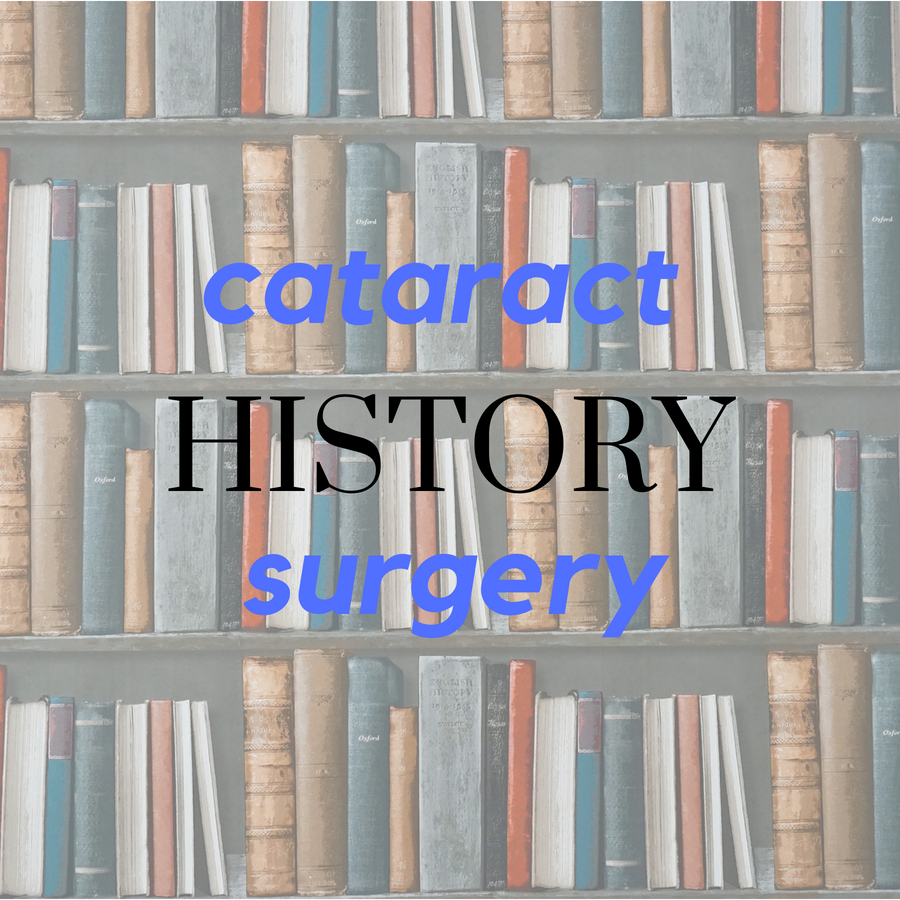Brief History of Cataract Surgery
June 25, 2018

Cataract surgery is one of the most common surgical procedures and it is also one of the oldest. Cataract surgery was first documented more than 2500 years ago. The earliest recorded technique for cataract removal was couching.
This article is within a series to recognized "Cataract Awareness Month." If you have questions about cataracts, cataract surgery or the symptoms of cataracts please call us.
Couching - Pushing Lens into Eye
Couching was a method of dislodging the clouded lens with a needle and then pushing it into the eye where it was absorbed. This technique allowed patients who barely saw light, to gain some improvement, yet this was nothing like the improvements seen with modern cataract surgery.
This procedure did allow light back into the eye, but without a lens the restored vision was severely unfocused. Many times, the practitioner only succeeded in blinding the patient. And other times, even if the operation was successful enough to push the lens away and allow unfocused vision, the patient might later die from an infection.
The couching technique could only be performed after a cataract had become “ripe." The term meant that the cataract was rigid and opaque.
The discovery of the microscope in 1661 allowed better understanding of the eye and brought about the next advance in cataract surgery.
First Removal of Lens
In Paris in 1747, Jacques Daviel performed the first surgical removal of a clouded lens. He presented a paper in 1752 to the French Royal Academy of Surgeons titled “A New Method of Curing Cataract by Removing the Lens.” This was the beginning of modern cataract surgery.
The procedure removed the lens through a small incision along the cornea and after the procedure, patients had to be immobilized with sandbags placed around their heads to allow the incision to heal. Many patients did not survive the ordeal.
In the late 19th and early 20th centuries, the surgical procedure for removing cataracts had advances such as using forceps and suction cups to remove the cataract, and then aseptic (contamination-free) operating rooms and antibiotics for infection, but patients still had extremely blurry vision and had to rely on thick glasses to focus their vision.
Artificial Intraocular Implants
In 1940, ophthalmologist Harold Ridley was treating a fighter pilot who had acrylic shards in his eyes after a plane crash. Dr. Ridley noticed that the pilot’s body did not reject the acrylic shards and this got him thinking about using a plastic lens to replace the one removed during cataract surgery.
In 1949, Ridley implanted the first intraocular lens. Unfortunately, Ridley’s invention was not immediately accepted by the medical community. It took almost 30 years before artificial lenses became commonly used after cataract surgery.
Phacoemulsification
This cataract removal technique uses ultrasound to emulsify the lens. The emulsified lens is then suctioned away. Charles Kelman invented the procedure in 1967 after he noticed how his dentist used an ultrasound descaler to remove deposits of plaque and calculus.
Femtosecond Laser
The femtosecond laser was cleared for use by the FDA in 2010. A femtosecond is one quadrillionth of a second, or differently stated, it is one millionth of one billionth of a second. In other words, really, really fast.
The surgeon uses a 3D image of the eye to create a surgical plan and then programs the computer-controlled laser with that plan. The femtosecond laser uses ultrashort electromagnetic pulses to create the incision, remove the front portion of the capsule (to gain access to the lens), and then additional pulses to soften and break up the clouded lens for removal.
If You Need Cataract Surgery
If you are experiencing visual difficulties because of cataracts, talk to an ophthalmologist and find out which procedure and artificial lenses are right for you.
Today there are several types of replacement lenses to choose from and the procedure to remove the cataract and insert the lens, whether it is phacoemulsification or femtosecond laser, is one of the safest and most successful surgeries.
If you would like to make an appointment with Drs. Whitten or Rose, you may CALL US or USE OUR CONTACT FORM.



